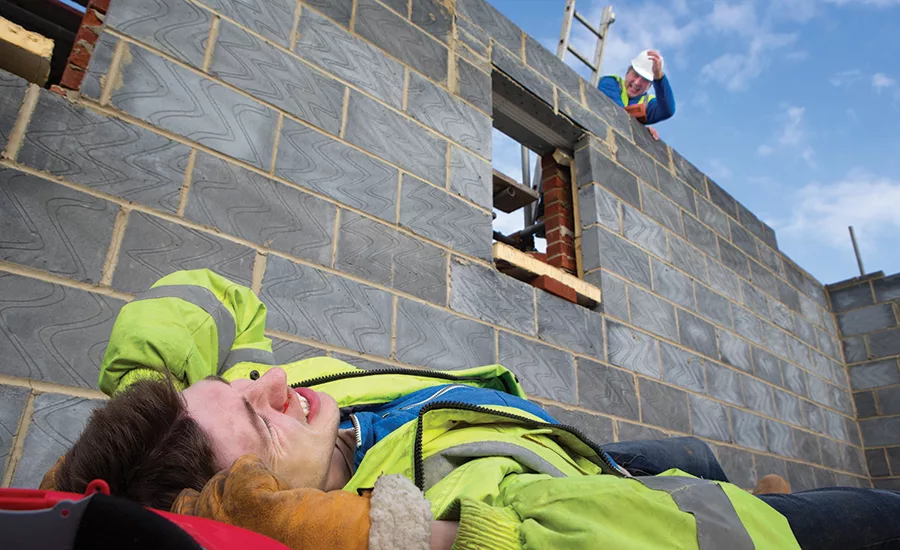Roofing is a Dangerous Business
Let's hope a death or major accident never happens, but the odd are not in your favor


No roofing contractor or any other construction worker goes to the jobsite on a given day and expects to die — but the harsh truth is that people do.
Roofing is a dangerous business. Forbes magazine recently listed roofing as the 6th most dangerous job in America. The U.S. Department of Labor reports that out of the 4,251 private industry deaths in the U.S. workplace during 2014, 20.5 percent were in construction. As far as a percentage of deaths, fall deaths are unequivocally number one. Falls represent 39.9 percent of all deaths, followed by
electrocutions (8.5 percent), getting struck by an object (8.4 percent) and getting caught in between machinery (1.4 percent). Death by falling is about twice as common as the next three causes.
Fall protection is also the Occupational Safety and Health Administration’s (OSHA) top listed citation annually. Yes, there are lots of complaints regarding OSHA, but since its founding 43 years ago, workplace deaths have dropped from 38 to 12 a day, on average. Another interesting fact is that 16 percent of workplace deaths — or two a day — are identified as Hispanic or Latino workers.
I’m not an expert on OSHA regulations and I’m not going to claim to know what to tell you to do in regards to workplace safety rules. There are plenty of folks out there that can do a good job of that. However, I’m the guy my customers call when a death occurs and we shed a tear together.
So, I see and experience the pain of such awful accidents. One such conversation happened earlier this year. Training, harnesses, and rope were provided, but a long-term employee who knew better failed to hook up for a quick job and fell a few feet to his death. While the owner was upset, ultimately, he knew he was doing the right thing and his employee made a tragic mistake by not following company policy. Do you know if you’re doing the right thing?
Like I said, I’m no expert on policy but there are a couple of key management factors I can advise you on. First, do you have emergency contacts for every employee? It’s tough to find that information in the spur of the moment. Also, are you going to notify the person or have the police handle it? I know what your lawyer will tell you, but you have to decide what the right thing is for you.
Next, do you have instructions on what to do in case of a major accident? The insurance company information, workers comp. info, etc. And last but not least, do you have a safety consultant’s cell number? I advise every roofing contractor to call one and have a consultant do some work for you so you have access to that person when a major incident occurs. Having a professional to communicate with your employees and OSHA in such an emotional situation is a must.
It all boils down to whether you’re doing the right thing.
By the way, did I mention that you, as owners and supervisors, can go to jail under the wrong circumstances? OSHA can’t prosecute you, but they can turn you over to someone that can. In 2011, CBS News in the San Francisco Bay area reported the conviction of Sam Hyung Goo Shim. The 68-year-old owner of the company where a death occurred received a year in county jail. Jwa Young Kim, 56, the foreman at the site, was sentenced to 364 days in jail.
Shim’s company, California C&R Inc., was also prosecuted and convicted in the man’s death.
Last December, James McCullagh, a 60-year-old roofing contractor from the Philadelphia area, pleaded guilty to four criminal counts after a worker died on a jobsite where the company failed to provide fall protection. He also admitted to telling investigators that he provided safety equipment and pleaded guilty to obstruction of justice. In April, a judge sentenced him to 10 months in prison and the company had to pay OSHA $71,600 in penalties, court records show.
Look, you can kid yourself about having a shoddy, token attempt at a safety program, but when tragedy strikes, reality sets in and the truth always comes out.
Let’s talk about roofers that use subcontractors. Since you call a person a subcontractor or give them a 1099 form, it means that they are one. However, if someone falls and is injured or dies, don’t be surprised if some lawyer tries to classify the sub as an employee.
Many roofers use questionable subcontractor practices. Be careful because if something happens, you could find yourself with a lot of liability. You also, as a general trades contractor, have definitive responsibilities regarding subcontractor safety. An undocumented subcontractor can simply slip away and you’re the only person stable enough to find and blame. Know the law and what the requirements are.
Let’s hope a death or major accident never happens, but the odds are not in your favor. Playing roofing contractor with poor safety practices is a little like playing Russian roulette.
Looking for a reprint of this article?
From high-res PDFs to custom plaques, order your copy today!




